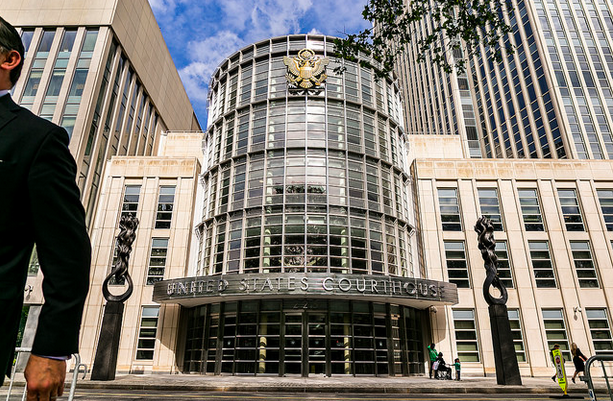
Adi Talwar
The federal courthouse in Brooklyn could see harsher sentences under the new policy.
During President Trump’s first 100 days, the national conversation turned on big ideas: whether it was right to bar refugees, whether Obamacare was worth keeping, and more. Over the next several weeks, City Limits will explore less recognized ways in which the Trump administration and its supporters might affect life in New York.
* * *
On May 10, Attorney General Jeff Sessions issued a memo instructing federal prosecutors to “charge and pursue the most serious, readily provable offense,” essentially eliminating the current policy, which is based on a 2013 memo from previous Attorney General Eric Holder, whose so-called “Smart on Crime” approach was to use discretion on cases involving offenders facing harsh mandatory minimum sentences.
Under the Holder memo, City Limits found that low-level dealers ensnared in widespread federal drug investigations in New York City have not always had the book thrown at them. That will change under this new memo. Some defendants as recently as three weeks ago accepted plea offers that may not exist under this new directive.
Sessions’ policy is a complete turnaround from Holder that advocates say will result in longer sentences for low-level drug dealers and a return to the “tough on crime” days that caused the prison population to skyrocket.
In New York, this means harsher sentences in the types of drug cases that the U.S. Attorney for the Southern District of New York (which covers the Bronx and Manhattan) regularly brings into court.
One such case is from a year ago, when U.S. Attorney Preet Bharara charged 32 East Harlemites with “narcotics trafficking,” the result of a long-term federal investigation into drug dealing at the Lincoln Houses that began way back in 2008.
Bharara gained a national reputation for taking on Wall Street and corrupt politicians, but to some locals they’ll remember him for spearheading controversial widespread drug investigations that often scooped up low-level dealers and charged them with conspiracy to distribute narcotics, which carry lengthy sentences.
“As alleged, these defendants blanketed the entire expanse of the Lincoln Houses with their round-the-clock drug dealing operation, using guns and violence to protect it,” Bharara said in the press release, which also boasted that, “All of the defendants face mandatory minimum prison terms ranging from 10 years to 15 years, and maximum terms of life in prison.”
The reality was far from the press release, however. Many of those charged were low-level dealers and when their cases got to court, they were offered plea deals by Bharara’s office much lower than the mandatory minimum 10 years. So despite the pomp, when it came to actual punishments, Bharara’s office followed the 2013 Holder memo which said, “Long sentences for low-level, non-violent drug offenses do not promote public safety, deterrence, and rehabilitation.”
10 to Life
One of these low-level dealers in the Lincoln Houses case was Rasheed Bailey, a 22-year-old who was charged with conspiracy to distribute more than 280 grams of crack cocaine, which carries a mandatory minimum of 10 years and a maximum penalty of life imprisonment.
Rasheed grew up in East Harlem in a broken home. “His parents essentially abandoned him at birth, leaving him with no mother or father to guide him … He began using drugs in his early teens; dropped out of school; and even started carrying a gun upon advice from his friends,” reads his sentencing memo.
At 15, he gave birth to a son. At 16, he was arrested for gun possession. He was tried as an adult, convicted and spent four years in prison. He earned a GED in prison, but when he got out he started hanging out with the same friends. He lived in three-quarter houses, shelters and was “essentially homeless,” according to his attorney.
He started using drugs again and then started selling them — including three times to an undercover police officer — which resulted in his arrest in March 2016. During his pre-trial supervision, he moved to Binghamton to escape his East Harlem life. He got a job at a Macy’s and volunteered to do post-offense rehabilitation with the Fast Forward Project.
“Through getting to know Rasheed in the 12 weeks that we were in class, we learned that this period in his life was one of refection and a desire to change,” reads a letter from two facilitators at Fast Forward to the judge in Bailey’s case to consider during sentencing. “We learned about his upbringing, his experiences during prior incarceration and his desire to make the necessary changes in his lifestyle to not end up in the same situation again. We were taken aback by his descriptive articulation and insight.”
“He wants to fill out school applications, find a good job and be there for his child.”
Federal prosecutors could have thrown the book at Bailey. He was caught red-handed. He was facing a mandatory minimum of 10 years. But he showed signs he wanted to change, had never been arrested for selling drugs before and was a “minor, low level street dealer,” according to his attorney.
So on January 11, nine days before President Donald Trump’s inauguration, prosecutors offered him a deal where if he plead guilty to dealing a lesser amount of drugs, he’d face a sentencing window of 41 to 51 months. Prosecutors could have gone even higher here because the United States Probation Department calculated a guideline range of 57 to 71 months, which was notched up 12 months because he had two convictions for marijuana possession. Prosecutors, however, again likely following Holder’s memo, were content with the 41 to 51 months guideline. A judge sentenced him to the bottom of the guideline, 41 months, and he is currently in Federal Correctional Institution Fort Dix in New Jersey.
If Bailey serves his full sentence, he’ll get out when his son is 10 and not 17, which would have been the case if he was sentenced to the mandatory minimum. He may be one of the last ones to get that leniency now that the Sessions memo is policy.
The memo does say that sometimes a harsh punishment is not warranted, but that a prosecutor must get that variance approved by a U.S. Attorney. In a separate March memo, Sessions wrote that “many violent crimes are driven by drug trafficking” and that “disrupting and dismantling those drug organizations … can drive violent crime down.”
Since Bailey was arrested as part of “disrupting” a drug organization, he seems to fit the bill for the type of offender that will face harsher punishments under Sessions.
“The assurances are, ‘Oh it’s just the major guys, we’re only going after—the big fish. That’s how these are always set up and that’s never how it turns out,” says Kevin Ring, a self-described conservative who serves as executive director of the nonprofit advocacy organization Families Against Mandatory Minimums.
Bailey’s court-appointed attorney, Gregory Morvillo of Morvillo LLP, said if prosecutors follow the Sessions memo it’d be a “stark turnaround.”
“If somebody who has had the same experience with the same conduct that Mr. Bailey has, gets 10 years on a forced mandatory minimum, that would be absolute miscarriage of justice,” he said.
Un-intentions
The federal prison population increased every year from 1980 to 2013, when it started to come down slightly. Nationally, violent crime and property crime went up from 1980 to 1994, but has been decreasing steadily since. So in 2013, when the federal prison population was at its height, the overall violent crime rate was at its lowest since 1970, according to the U.S. Department of Justice’s Uniform Crime Reporting Statistics. The overall property crime rate was at its lowest since 1967.
The overall crime rate in New York City has followed similar trends, according to the NYPD. The overall crimes reported in the five boroughs are about a fifth of what they were in the early 1990s.
David C. Condliffe, executive director of the New York-based Center for Community Alternatives, pointed to a recent report by former Chief Judge of the New York Court of Appeals, Jonathan Lippman, that concluded New York City’s criminal justice system needs dramatic change because “more jail does not equal greater public safety.”
“Incarceration is not increasing public safety. In fact, we’ve been able to increase public safety while we’ve reduced incarceration in New York State. This puts all of that wisdom on its head,” says Condliffe.
“Why Sessions is so backward on this is so puzzling to me.”
Sentencing reform has been a bipartisan issue, as more states are seeing that “tough on crime” policies of the 1980s and 1990s put away too many nonviolent offenders for far too long — causing overcrowded prisons and ripping apart communities where more children grow up with parents in prison.
Ring says the Sessions memo is a return to a failed approach that will result in unnecessarily longer sentences.
“Sessions has put his thumb on one side of the scale and said, ‘You need to charge to the gills,’ and that’s going to trigger mandatories in more cases,” says Ring.
“And if you go after more low-level drug offenders, that’s fewer violent offenders they are going to go after.”
It may also result in more defendants deciding to go to trial. Right now, barely any defendants go to trial. In 2016 in the Southern District of New York, 96.4 percent of cases resulted in a plea, which is actually below the national 97.3 percent mark. For drug cases in the Second Circuit, which includes all of New York, 97.4 drug dealing cases resulted in a plea.
“Frankly, I don’t know what is going to happen based on the Sessions memo. The practical reality of it is prosecutors’ offices can’t believe that most people are going to plead for the mandatory minimums, therefore a potential problem is that it would back up the courts,” said Morvillo.
‘Extraordinary Power’
One interesting question about the Bailey case mentioned above is why he was facing federal charges anyway. His case is the type of case some local public defenders have complained about for years. Even though prosecutors followed Holder’s lead in reducing charges, he was charged with low-level dealing that is usually handled in state court, where sentencing guidelines are lower and there are alternatives to incarceration including drug court.
But Bailey was ensnared in one of a string of cases spearheaded by Bharara to crack down on the drug trade in the Bronx and Manhattan. Defense attorneys in New York have been critical of these types of cases.
David Patton of the Federal Defenders of New York wrote in an op-ed in March that Bharara “greatly increased the prosecution of poor people of color using sprawling conspiracy and racketeering statutes to charge many low level drug dealers and addicts together with bigger players in the same indictments.”
“He also continued the programs begun by his predecessors in the Bush administration of prosecuting people for street crimes that were once considered the exclusive province of state courts,” Patton continued.
So what will we see from Bharara’s yet-to-be appointed successor, a Trump appointee who will operate under this new “tough on crime” memo?
Advocates are not looking forward to finding out.
“This memo gives the prosecutors such extraordinary power,” says Ring. “I can’t understand it from a conservative perspective. You know, we’re always worried about the overzealous FDA or EPA official or IRS bureaucrat, and this is a government actor who can put people in prison for decades and there’s no power we won’t give them.”

Gage Skidmore







